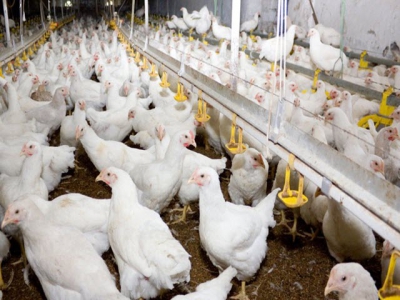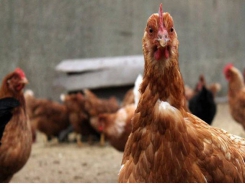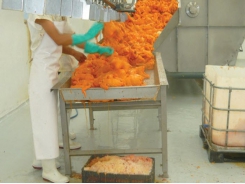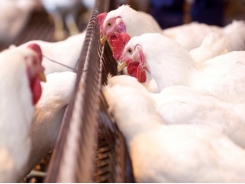Broiler digestion and gut health could benefit from probiotic vaccine combo

A study shows combining an anti-coccidial vaccine and a product containing three probiotics and one prebiotic had a positive impact on the zootechnical performance of broilers, and the coccidiosis lesion scoring after the experimental induction of coccidiosis, says an expert.
Martina Dardi, product manager, poultry at HIPRA in Spain, was presenting at the World Nutrition Forum in Cape Town last month on the findings of research that she carried out with Biomin.
Results of their study, said Dardi, showed combining HIPRACOX, a vaccine marketed by HIPRA and containing precocious sporulated oocysts of Eimeria acervulina 003, E. maxima 013, E. mitis 006, E. praecox 007 and E. tenella 004, with Biomin’s PoultryStar, a synergistic combination of probiotics - Enterococcus sp, Bifidobacterium sp., and Lactobacillus sp., and one prebiotic, fructooligosaccharide (FOS) derived from inulin - demonstrated a beneficial effect on digestion and overall gut health in broilers.
Further studies in Necrotic enteritis (NE) challenged broilers are needed though, she said.
However, her take home messages were:
- The combination of probiotics, a prebiotic and the coccidia vaccine could be beneficial in that they could improve overall mortality due to coccidia infection,
- Probiotics competitively exclude enteric pathogens such as E. coli, Clostridium perfringens and Salmonella which might coincide with coccidia vaccination, and
- Probiotic immune modulators improve vaccine efficiency.
Concerns about enteric pathogen resistance
Coccidiosis is a high-risk infection in modern commercial poultry systems, as well as being capable of causing considerable economic losses to any medium-and large-scale operation. To minimize the effect of this parasitic disease, producers have typically relied on veterinary drugs such as coccidiostats. However, there are concerns about enteric pathogen resistance because of the prolonged use of these drugs. Therefore, new tools, such as anti-coccidial vaccines and probiotics have drawn the attention of poultry producers, said Dardi.
She said live attenuated coccidiosis vaccines have the advantage of providing:
- Good and long-lasting protection against coccidian invasion,
- They are capable of restoring sensitivity against anti-coccidials,
- They are specifically designed to generate an immune response, and
- Attenuated vaccines limit the threat of possible adverse events
Probiotics, also known as direct-fed microbials, are classified as live non-pathogenic microorganisms. She said they are:
- Capable of maintaining a normal gut microbial population
- They have multiple modes of action: comprising pathogen antagonism, competitive exclusion and stimulation of the immune system
- They help to maintain a healthy balance of the gut microorganisms
- They provide overall benefits in terms of performance, protection against enteric diseases and immunity of the bird
The study
The team, she explained, set about evaluating the added protective effect of the symbiotic product in broilers vaccinated against coccidiosis with the HIPRA vaccine immediately after hatching and challenged with a coccidia species mixture at day 15.
In terms of the methodology, she said 456 day-old male broilers of the Ross 308 breed were housed for a 35-days grow out in floor pens covered with wood shavings in a thickness of about 5 cm. Pelleted feed and water were provided ad libitum. The commercial feed did not contain antimicrobials or anti-coccidial additives, she added.
The animals were divided into three treatment groups of 152 animals with eight replicates per group:
- Uninfected untreated control (UUC): Unchallenged, No PoultryStar, No HIPRACOX
- Infected untreated control (IUC): Challenged, No PoultryStar, No HIPRACOX
- Treatment group (HCPS): Challenged, PoultryStar (water and feed) plus HIPRACOX
She said that the HCPS group received a HIPRACOX vaccination on the farm on arrival day via drinking water in bell drinkers and PoultryStar sol (20mg/bird/day) via drinking water with bell drinkers for the first 3 days. PoultryStar me was applied via feed 1kg/ton during the starter phase (1-14) and 0.5kg/ton during the grower phase (15-35).
The birds in the IUC and the HCPS groups were challenged with Eimeria strains from pathogenic strains isolated in Germany.
She said that on days 21 and 22, two birds per pen were randomly selected, individually weighed, and then humanely euthanized for lesion scores assessment. Oocysts per gram (OPG) was analyzed on days 6 and 7, 22 and 29. Performance parameters were recorded on day 1, 8, 15, 22 and 35, mortality was recorded daily, and statistical analysis were conducted.
Results
Dardi explained that the team found the lesion scores in birds from the HCPS group were always lower compared to the IUC group.
The HCPS group showed, as expected, vaccine replication OPG levels on days 6 and 7, while on day 22, oocyst output was less than half of the level shown by the IUC group, revealing, she said, that birds in the HCPS were already immunized and well protected at the time of the challenge.
Mortality in the HCPS group was numerically far lower compared to the IUC group, she added.
She said the team did not observe significant differences amongst the three groups with regard to daily feed intake. However, they saw that daily weight gain was “significantly better” in the UUC and HCPS groups.
The results also showed, she said, that birds from the UUC group performed significantly better compared to birds from the IUC group regarding bodyweight and FCR.
Birds treated with HIPRACOX + PoultryStar performed better compared to birds from the IUC groups regarding FCR (UUC 1.43, IUC 1.58, HCPS 1.52), she added.
Overall, the HCPS group and the UUC group gained significantly more weight compared to birds from the IUC group, said Dardi.
Source: World Nutrition Forum, SCOPE, Cape Town, October 3-5 2018
Authors: M. Dardi, M. Pagès, B. Syed, L. Valenzuela
Related news
Tools

Phối trộn thức ăn chăn nuôi

Pha dung dịch thủy canh

Định mức cho tôm ăn

Phối trộn phân bón NPK

Xác định tỷ lệ tôm sống

Chuyển đổi đơn vị phân bón

Xác định công suất sục khí

Chuyển đổi đơn vị tôm

Tính diện tích nhà kính

Tính thể tích ao




 New DSM essential oil product ‘improves feed conversion…
New DSM essential oil product ‘improves feed conversion…  Choosing the optimal feeding system for breeders
Choosing the optimal feeding system for breeders